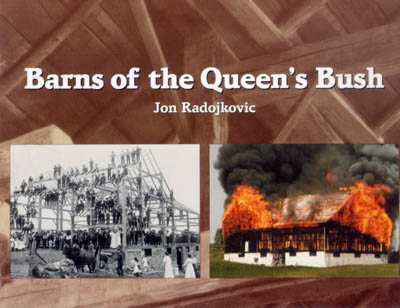 |
November 2, 2001
Barns: An Important Part of Our Heritage
|
For those of us who live in rural northern Ontario, barns are directly
or indirectly a part of our lives. We may work in them, or simply see them
on our travels, but these remarkable buildings are always there on the
landscape. There have been many books written on the romance of barns,
but a new Ontario book called Barns of the Queen's Bush (by Jon Radoskovic,
Brucedale Press, June 2001) was reviewed on CBC radio recently (see cover
opposite). I ordered a copy from Gulliver's and received it in three days.
I found the profiles of twenty three barns and two mills a fascinating
read. The book is an ideal Christmas gift for anyone interested in building,
repairing, maintaining or fantasizing about barns.
 |
New book on Ontario barns. A fascinating read. Now available
Online from the Past Forward Company Store.
[More
information]
|
Of all of the thousands of barns built throughout the north in the last
century, I will look briefly in the space I have available here at one
close by in south Chisholm Township where I live. The Fred Edington family,
owners of the land that I have a part of, moved here a hundred years ago
and cleared a farm out of the bush and lived here until the late 1960s.
Mr Edington worked in the bush for William Foster, of Fossmill fame, and
later at a Foster mill at the back of their property. Mrs. Edington worked
as a cook at these camps. They got their first team by cutting hemlock
bark for sale to tanneries to be used in curing leather.
The romance of barns is no better illustrated than along Bear Mountain
Road where I live. Fred Rawlinson and his wife, who were cotton weavers
from England, came here in 1894 and settled down the road a mile east by
the Genese Creek. Local farmers helped them build a 12 x 20 log house the
year they arrived, and later helped build a small barn. Their friends the
Edingtons, who were also cotton weavers from England, came and stayed with
them for a couple of years before settling on 200 acres nearby.
The Rawlinsons moved elsewhere in Chisholm a few years later, but the
Edingtons stayed until 1970 when they moved near Powassan, where Jim and
Ron Edington still farm today. The Edingtons built their first barn with
the help of neighbours in 1907. Many of these neighbours had come to work
at a nearby logging operation. One of those men was Robert Stockhill, who
homesteaded west of the Edingtons on the same road as the Edingtons and
Rawlinsons. George Stockhill, one of his sons, became a well-known timber
framer and built many Chisholm barns, including the Edington's. George
had thirteen children, and many of his descendants remain in the area today.
The Edington family history notes that George Stockhill built their barn,
which was "the first frame barn in this part of Chisholm." The Edingtons
added to the barn later as their Ayrshire herd expanded. The photo shows
the neighbours helping assemble the frame on the extension.
 |
Team of neighbours building addition on the Edington barn
in Chisholm Township in the 1930s. |
The Edington barn was built much like many of those in the new book
mentioned above. A concrete foundation housed the cattle and the second
floor, accessed by a ramp, held the hay, threshed and stored the grain,
and protected the farm equipment. These old barns used square timbers,
which were squared by hand or, where possible, at a sawmill. The joints
were hand hewn by experts who knew the techniques and who could engineer
the barn raising. In the very early days the barns were made completely
from logs. The tiny building just to the right of the barn in the landscape
photo (see below) was made completely of cedar and was relocated to my
property thirty years ago, where it remains today in good condition decades
after it was originally constructed.
 |
The Edington farm site looking north toward Wasi Lake in
1972, showing the barn starting to collapse soon after the family moved.
Doug Mackey photo. |
Books about barns show numerous variations, including round, double
and U-shaped barns, with various roof designs and entrances. My ancestors
were United Empire Loyalists who settled originally on the Hudson River
in New York state, where their barns had the entrances on the ends rather
than on the side. Barn foundations have varied as well, from nothing, to
stone, to concrete, and to blocks. Many barns were expanded, rebuilt and
occasionally moved. In a recent conversation with Cleve Way of Callander,
he told me how his father Dillon moved a barn from the original site of
Powassan at the Bingham chute on the South River to their farm on the 12th
concession in South Himsworth, where it remains today.
For further information on barns, check your local library where several
excellent books are available, including the one mentioned above. The Internet
also has a wide variety of sites related to "barns." Have fun harvesting
your heritage.
Heritage Perspective Home Page
|

![]() Past
Forward is now on Facebook "LIKE" us to keep in touch
Past
Forward is now on Facebook "LIKE" us to keep in touch